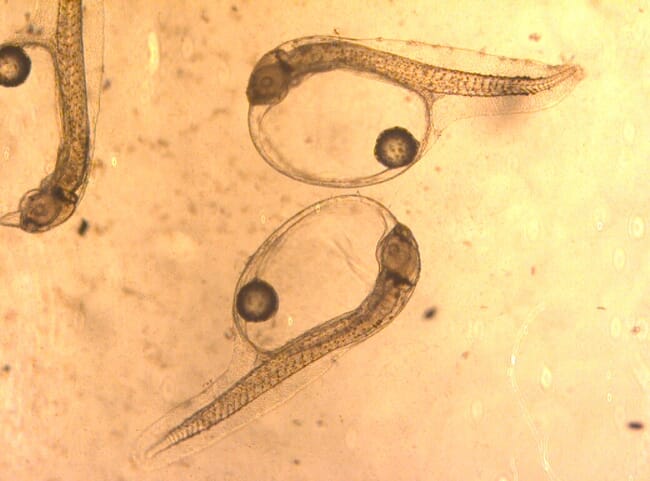
© CMFRI
Marine fish larvae need to be in an environment where food is abundant and where they are able to extract the energy they need to grow and develop rapidly. These environmental factors are crucial in increasing the larvae’s chances of surviving to adulthood.
The larval period is a temporary period where fish display high growth rates and begin to differentiate their tissue and organ systems. This allows them to transition from larvae to juvenile fish. Since digestive processes begin developing in the larval stage, researchers are beginning to focus their on this development period – hoping to understand how the fish regulate these processes.
In addition to digestive capability, external factors like light and temperature are known to influence food intake when fish are in the larval stage. High light intensity (1,000 – 3,000 lux) at the water’s surface is normally recommended for larval rearing of sea bream (Sparus aurata) and sea bass (Dicentrarchus labrax) up to 25 days post-hatch (DPH), followed by a decrease to 500 – 1,000 lux.

A team of researchers from the Portuguese Institute for Sea and Atmosphere/EPPO, Bivalvia-Mariscos da Formosa, Lda, SPAROS Lda, University of Bergen and the Center of Marine Sciences (CCMAR) of the Universidade do Algarve analysed how the incidence and intensity of feeding of sea bream (Sparus aurata) larvae were affected by the time if day, light and water temperature, by analysing the intestinal content and how this affected the content of cholecystokinin (CCK).
The experiment
The researchers established a temperature of 19˚C to 20˚C and under a light intensity of 1,000 lux at the water’s surface, mirroring normal rearing conditions. Their study period began at the hatching stage and extended to 25 days post hatch, and further to when maturation of important digestive functions is reached. The researchers stopped monitoring the larvae when they had reached the juvenile stage, at around 1 g wet weight (100 to120 DPH).
"Understanding the factors that affect the feeding behaviour and digestive processes of marine fish larvae could help optimise feeding protocols for commercial fish species," the researchers note.
The feeding behaviour of sea bream larvae
“The lower incidence of feeding observed in the youngest larvae seems to be explained by the lower development of the capture structures and the lower experience”, they report.
They also highlight that the striking increase in feeding intensity with age suggests a higher energy demand in the larval development stage, which may be related to the acquisition of new skills and the maturation of the biological systems and physiological functions involved in feed capture and digestion.
“Another important result of this study was the high individual variability that this could have in the development of fish larvae. Taking into account that prey represent a source of energy for the different metabolic needs of fish larvae, and that the basal metabolic costs are similar, the individual energy budget will be remarkably different between fish of the same age”, the scientists reported.

© SAIC
The importance of light intensity
Food intake in gilthead sea bream larvae clearly decreased under darkness, and the decrease was more noticeable for larvae in the youngest stages of development. This finding is in line with other observations, as light is known to affect the feeding behaviour of marine fish larvae. The larvae need to see their prey to feed successfully.
The feeding responses of sea bream larvae improved as they developed new physical abilities to capture and process the food they ingested.
"This study gave us new insights into the hypothesis that younger stages rely primarily on visual stimuli to capture food, while older larvae can successfully perceive and capture prey even in dark environments, relative to the development of the eyes”, they conclude.
According to the researchers, their observations suggest that around 49 DPH, the sea breams acquire new competencies and biological functionalities; however, up to 38 DPH, light is important for the foraging ability of sea bream larvae. The researchers also report that cholecystokinin (CCK) maturation functionality was only observed at later stages.




